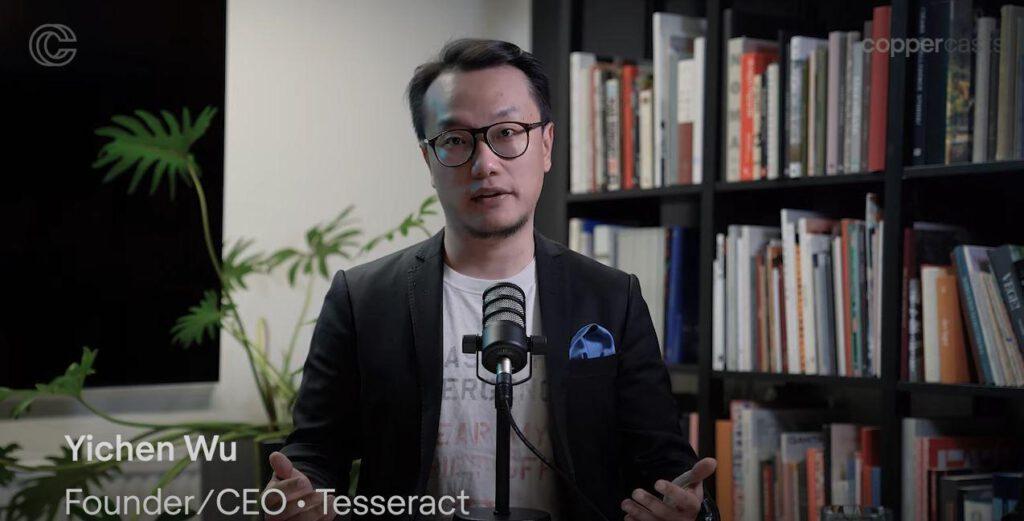This article is a summary of a podcast and video recorded by Tesseract CEO Yichen Wu in December 2020 and published on the podcast series Coppercasts on 22.12.2020. Link to the recording and video can be found here.
Crypto lending has experienced a huge proliferation in volume in the past two years, with the latter seeing the amount of active credit increasing six-fold to over 10 billion USD – a historically high growth rate. This nascent sector, however, is still missing much of the capital efficiency of conventionalized finance. According to CEO Yichen Wu, Tesseract’s mission as a company is to find what institutional investors appreciate in conventionalized finance markets and bring it into the world of crypto.
Mr Wu defines the single biggest achievement of the company to be implementing automation in digital lending. In crypto lending, hedging against credit risk is difficult due to the global footprint of crypto as well as a lack of regulation. The problem is often solved by charging collateral in excess of the loan principal, eliminating a lender’s risk of capital loss. This is called overcollateralization.

Overcollateralization leads to capital inefficiency since the collateral effectively becomes an opportunity cost for the borrower. Tesseract has succeeded in implementing an effective margin lending framework to the sector, allowing borrowers to trade with their entire position. This margin lending framework was released to public use in October 2020 in co-operation with Copper. Thanks to the company’s ground-breaking software APIs, collateral positions are known in real-time and risk management and margin call procedures work automatically.
Crypto lending as a sector is “still in its infancy but staring to get more adult”, Mr Wu says. He describes the situation crypto industry faces as “herding”: people examine closely what industry leaders are doing and then follow their example, like a flock of sheep. He goes on to say that crypto will be ready to enter the finance mainstream only after a top-tier allocator in traditional credit markets finally makes a prominent entry into the industry.
When it comes to institutionalization in crypto, lack of regulatory clarity has generally been perceived as one of the biggest obstacles. Mr Wu says, however, that regulators have been “right to take a slow and prudent approach to crypto”: for them, it is essential to see beyond short-term trends in new asset classes since their regulation decisions could impact the industry for decades. Seeing that crypto finance is still developing and evolving at an incredible pace, it is only right for the regulators to take their time.
One of the biggest challenges Tesseract and other companies in the sector face is attracting enough talented people to work in the industry. Though crypto has already caught the interest of some of the brightest minds in finance, its reputation is marred by scandals – according to Mr Wu, many prospective candidates are apprehensive about what these negative connotations will have on their own professional reputation. He says that the industry needs to “nurture” this “shallow crypto talent pool”: a more established status for crypto will attract a wider pool of talented job applicants who in turn will develop the industry further, cementing its standing on the side of traditional finance.
In light of this discussion about institutionalisation in crypto, Mr Wu is proud to say that Tesseract has recently secured a million-dollar loan from OP, Finland’s largest and “most conservative” commercial bank. He says that the point of acquiring the loan was not primarily to raise capital; instead, it was to showcase the company’s maturity and how far it has come in under four years. Having secured the loan implies two milestones for the company. Firstly, Tesseract has cleared all major regulatory and reputational hurdles, and secondly, the company is now stably profitable – something that is exceedingly rare for a young start-up.
Tesseract has been inside the crypto lending inner circle for years and Mr Wu has a clear image of the company’s strengths relative to others in the field. Tesseract’s proprietary risk engine technology and deep understanding of the needs of investors and borrowers alike are some of the company’s biggest assets. Looking forward, Mr Wu does not see Tesseract becoming a fully-fledged service provider as many of its counterparts in digital finance. Rather, he wants Tesseract to focus on operations where it is the industry leader and a gain an ever-greater edge – ultimately to become their institutional backbone infrastructure. This will provide the company a sustainable competitive advantage going forward.
In conclusion, Tesseract is not to aiming to become the “biggest player” in crypto lending but rather an institutional authority in a highly specialised area. Mr Wu uses an apt comparison between regular soldiers and special forces to illustrate this. To conquer a country, you need a large marine regiment supported by numerous other military departments. In comparison, Tesseract sees itself as the Navy SEALs: a lean, mean and efficient organisation equipped to be the global leader in their highly specified area of prowess.